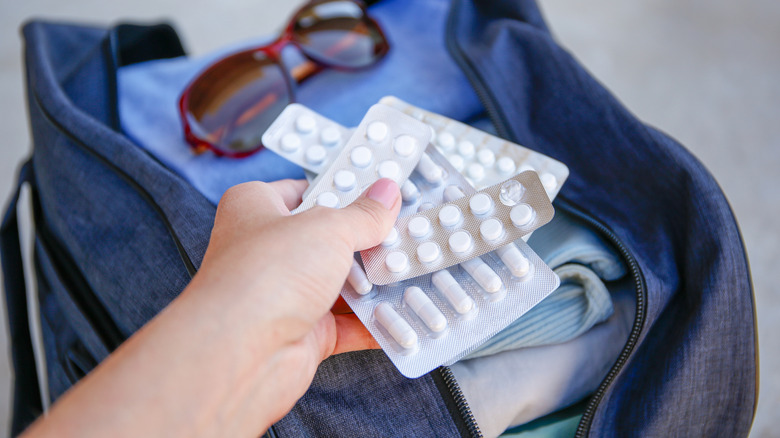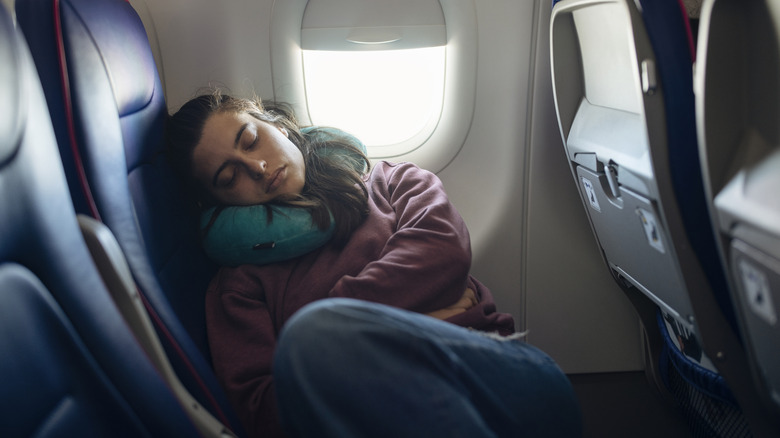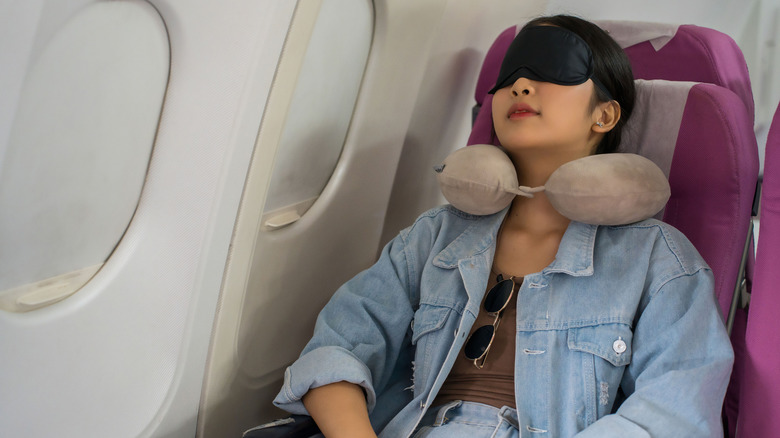The Popular Medicine Flight Attendants Prefer You Avoid Taking During A Flight
As you pack for that upcoming flight, you're likely prepping your carry-on with all the necessities, including medication. Common items like pain relievers, decongestants, and motion sickness medicine are typically fine to take when traveling. However, there are several things flight attendants wish you'd stop doing on flights, including using a specific medication: sleeping pills.
When it comes to sleep aids, flight attendant's main worry is the difficulty in distinguishing between a passenger who's simply in deep sleep and one who is experiencing a medical emergency. "I noticed a passenger looked unconscious to me. I tried to wake him up by shaking him, but he didn't respond, so I panicked and called my colleagues for help," one experienced flight attendant told Business Insider. Fortunately, in this case, they said that "the passenger was a heavy sleeper, and it looked like he'd used some sleeping medication."
For everyone's safety and peace of mind, avoid taking strong sleeping aids like benzodiazepines, Z-drugs, and powerful sedatives on board. Using these medications while flying can be unsafe — and not solely because you'll confuse cabin crew. However, just because these medications aren't recommended, doesn't mean you can't sleep on flights. So let's explore why strong sedatives are unsafe while flying and what you can do instead.
Why it's unsafe to use sleeping medication on a flight
It's unsafe to take sleeping pills on a plane for a few reasons, but an important one is that flight attendants might not be able to wake you. If they need you to adjust your seat or ask you to move and you're out cold, they can't manage these situations. If somebody next to you urgently needs to use the restroom, things may devolve quickly. Worse yet, an unconscious passenger could send flight attendants into a panic. Even if it's a false alarm, these situations can divert the cabin crew's attention from real emergencies.
Meanwhile, an actual emergency could create an even larger problem. Sleeping pills are known to make people groggy, making it hard to respond effectively. Using emergency gear like breathing masks or flotation devices could become challenging. Also, if your plane has to perform an emergency landing, you might not be able to evacuate quickly.
Furthermore, individual responses to medication vary widely. If you're trying a medicine for the first time, it may be stronger than expected, making it hard to catch that connecting flight. Plus, sleeping pills are known to have a wide range of possible side effects, including dizziness, drowsiness, and nausea. If you insist on taking sleeping medication while flying, we recommend speaking with a healthcare professional and weighing the pros and cons in advance.
Tips to sleep on airplanes without medication
Sleeping on airplanes isn't easy for everyone. While flight attendants often get special sleeping quarters, you might be stuck in a stiff seat with little legroom. Luckily, there are some great hacks to make flying a lot more comfortable, even in economy class. Before you book a flight, research different airlines' offerings. Consider your needs in terms of space and onboard amenities, and pick an airline accordingly. Also, it might be worth paying extra to choose a seat. If sleep is your main priority, the window seat is your best bet since it offers a built-in headrest and the luxury of not having to move for your seatmates.
Once aboard, it's crucial to create the right conditions for sleep. The first thing you should do before dozing off is fasten your seat belt. This will prevent the flight attendant from waking you up mid-snooze. Then, block out unnecessary sensory input. On long-haul flights, the difference between day and night can get murky, so if you want some shut-eye, imitate a nighttime experience with an eye mask. Noise-canceling headphones or earplugs can silence anything in the background. Lastly, an airplane pillow and a small blanket can help you get cozy. If the airline doesn't offer these, consider bringing your own or wearing an oversized sweater. And if you're craving another nap on your layover, check out the best ways to sleep at an airport.


